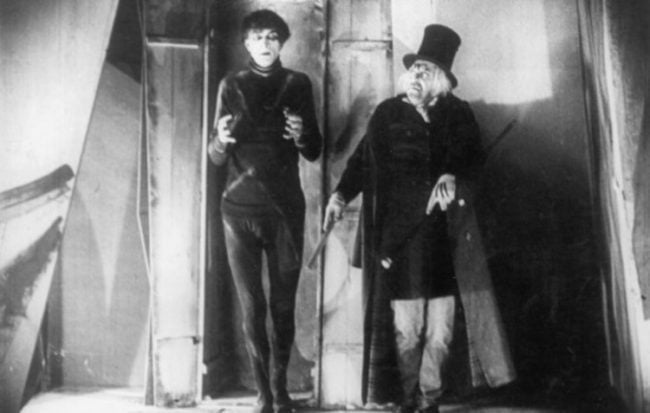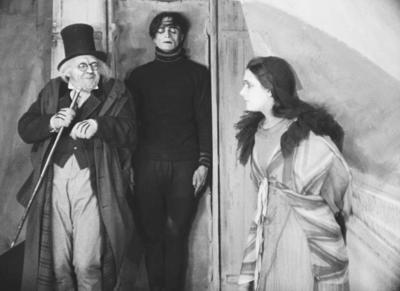
- Details:
- Directed by Robert Wiene
- Written by Carl Mayer, Hans Janowitz
- Released February 26, 1920
- Budget $12,371
- Box Office $4,714
- Cast Werner Krauss, Conrad Veidt, Friedrich Fehér, Rudolf Lettinger, and Lil Dagover
Break Down:
The film opens with two men sitting outside under a tree talking. The younger of the two men, Francis (Fredrich Feher), says that “the spirits have driven me away from my family and home.” Just as he says this, a ghostly woman dressed in all white and seemingly incoherent walks by them. The man explains that she is his fiancée and tells his friend they have been through a traumatic experience. As he begins telling the story, the scene changes to a flashback of what happened.
Here we are introduced to a mysterious man named Dr. Caligari (Werner Krauss). The Doctor is attempting to get a permit to perform his sideshow at the fair that just came into town. The clerk, however, is being extremely rude to him. After making fun of Caligari, the clerk approves the permit and leaves the room. Later that night, the clerk is found dead.
The next day, Francis and his good friend Alan decided to visit the fair. Francis and Alan are in love with the woman we are introduced to at the start of the film, the dazed woman in white, Jane (Lil Dagover). While the two friends are at the fair, they stop to see the sideshow. Part of the sideshow is Dr. Caligari’s Cabinet. The Doctor has a somnambulist with him, which is neither awake nor asleep, someone in a daze. The Doctor claims that his somnambulist, Cesare (Conrad Veidt), can see into the future and picks Alan to come to ask Cesare a question. Alan asks, “How long shall I live?” Cesare’s reply is, “The time is short. You die at dawn!” That night, someone breaks into Alan’s home and murders him while sleeping, the same way the clerk was murdered, stabbed to death.
Francis, along with Janes’s father, Dr. Olsen (Rudolf Lerringer), gets permission from the local police to investigate Alan’s death. They begin by searching out Dr. Caligari and Cesare to question them. They gain no information, and later that night, a man is caught attempting to murder a woman. The police assume he is the same killer. Still, the man confesses to the attempted murder and denies the two previous murders.
Late at night, Francis keeps an eye on Dr. Caligari and thinks Cesare is sleeping, but it is a fake in the box resting. Cesare breaks into Janes’s house and attempts to kidnap her. However, a group of people see this and begin chasing him, so in an attempt to lose his pursuers, he drops Janes’s body. He continues running, but soon, Cesare falls down, dead. Francis checks the box to find a dummy inside instead of Cesare, and the Doctor flees. Francis follows Caligari to a nearby insane asylum.

While Francis is looking into the asylum, he learns that Caligari is actually the asylum director. The staff begins to help Francis. Together, they find the Doctor’s journal that reveals his obsession with an 11th-century monk named Caligari. The monk used a somnambulist named Cesare to commit murders in Italy. Caligari becomes so consumed with this story that when a somnambulist comes into the asylum, Caligari begins experimenting on him. They soon become his Cesare. Now, more fit for a straitjacket than a white coat, Caligari becomes a patient in the very asylum he once ran.
The film then goes back to the beginning setting with the two men on a bench. However, it is then revealed that Francis is actually an inmate and Jane and Cesare, a quiet man who is not a somnambulist. Dr. Caligari is, in fact, the asylum director. Francis attacks the Doctor and is then thrown in a cell where the Doctor states, “Now that I understand his delusion, I am confident I can cure him.”
The Cabinet of Dr. Caligari has been called many things, and the masterpiece seems to fit the best. The layout of the “frame job” story is so well crafted that it still holds up decades later. The writers Hans Janowitz and Carl Mayer took moments from their own personal lives to create the suspense and horror portrayed in the film. The story that sticks out the most is the one Janowitz tells of a murder he witnessed in 1913. He was close to an amusement park and noticed a young girl going into some bushes. A few moments later, a man came out of the bushes, but the girl was never seen alive again. He learned the next day that she had been murdered. This moment in time stuck with Janowitz for perhaps some feelings of guilt for not stopping what happened. Much like Francis in the film, who is upset about Alan’s murder, especially since they were told Alan would die. Perhaps there was some guilt there or the feeling of remorse for not taking the situation seriously. Many critics claim that this early German film had undertones of following authority mindlessly and the dangers that can come with that. The critics claim that Cesare represents the German citizen who will blindly follow command and even kill if necessary. Although Janowitz and Mayer both had their issues and dislike for the military, there is little evidence that this was their intent when writing the film. It could be said, however, that their subconscious was deep at work while writing. Janowitz was actually an officer during the way. By the time he got out, he was bitter and resented the military. Mayer claimed he was unfit for the military due to his mental illness and spent some time in an asylum being monitored. It was in this asylum that he met a director who served as inspiration for Dr. Caligari. By the time Mayer was released, he also had a significant issue with authority. However, the original script that was found in 1950 shows no evidence that the writer’s intent was to make a statement with their film. Nonetheless, the idea was created and is heard to this day. Whether that statement was conscious, or subconscious we will never know.
Watch “The Cabinet of Dr. Caligari” on TheLastPicture.Show
Written exclusively for TheLastPicture.Show by Jacob Ruble
Disclosure: The links on this page are “Affiliate Links” and while these are shown at no costs to our viewers, they generate commissions for our website(s)

